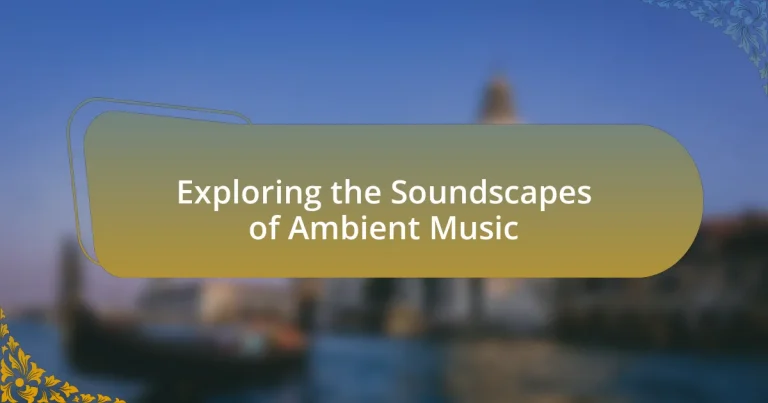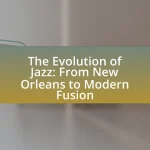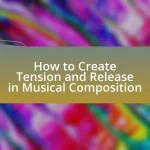Ambient music is a genre defined by its emphasis on tone and atmosphere rather than traditional musical structures and rhythms. This article explores the fundamental characteristics of ambient music, including its unique soundscapes, instrumentation, and emotional impacts. It examines how ambient music differs from other genres, its historical roots, and the evolution of its subgenres. Additionally, the article discusses the practical applications of ambient music in therapeutic settings, multimedia projects, and branding, while offering tips for enhancing the listening experience. Through this comprehensive overview, readers will gain a deeper understanding of ambient music’s significance and its role in contemporary culture.
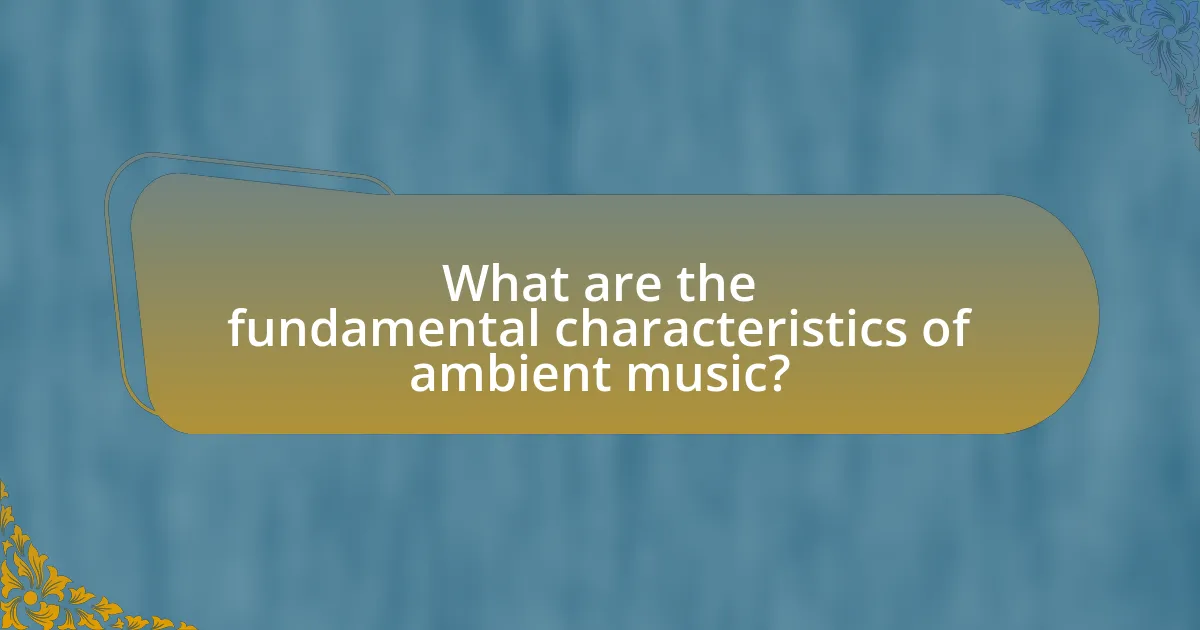
What are the fundamental characteristics of ambient music?
Ambient music is characterized by its focus on tone and atmosphere over traditional musical structure and rhythm. This genre often employs long, sustained sounds, minimalistic compositions, and a lack of prominent beats, creating an immersive auditory experience. Ambient music frequently utilizes electronic instruments and effects, such as reverb and delay, to enhance its ethereal quality. Notably, artists like Brian Eno, who is often credited with popularizing the genre, emphasize the importance of creating a sound environment that encourages relaxation and contemplation. The genre’s roots can be traced back to the 1970s, with influences from experimental and electronic music, further solidifying its unique position in the musical landscape.
How does ambient music differ from other genres?
Ambient music differs from other genres primarily in its focus on atmosphere and mood rather than traditional musical structure and rhythm. Unlike genres such as rock or pop, which emphasize melody and beat, ambient music prioritizes sound textures and sonic landscapes, often creating immersive environments that encourage relaxation or contemplation. This genre often utilizes long, sustained tones, minimalistic compositions, and non-linear progressions, which can evoke emotional responses without the need for lyrics or conventional song forms. The work of artists like Brian Eno, who is considered a pioneer of ambient music, exemplifies this approach, as his albums often feature extended pieces designed to be experienced as a whole rather than as individual tracks.
What elements define the soundscapes of ambient music?
The soundscapes of ambient music are defined by elements such as texture, timbre, space, and dynamics. Texture refers to the layering of sounds, creating a rich auditory experience, while timbre involves the unique quality of each sound, contributing to the overall atmosphere. Space is crucial in ambient music, as it often utilizes reverb and delay to evoke a sense of distance and environment. Dynamics play a role in the subtle variations in volume and intensity, enhancing the immersive quality of the soundscape. These elements collectively create an expansive and often meditative listening experience, as evidenced by the works of artists like Brian Eno, who pioneered ambient music with albums like “Music for Airports,” which exemplifies these characteristics through its serene and atmospheric compositions.
Why is atmosphere important in ambient music?
Atmosphere is crucial in ambient music because it creates an immersive experience that transports listeners to different emotional and spatial realms. This genre relies on sound textures, tonal colors, and subtle dynamics to evoke feelings of tranquility, introspection, or even tension, allowing the music to serve as a backdrop for contemplation or relaxation. Research indicates that ambient music can influence mood and cognitive states, enhancing focus and reducing stress, which underscores the importance of atmospheric elements in achieving these effects.
What role does instrumentation play in ambient music?
Instrumentation in ambient music serves to create atmospheric soundscapes that evoke emotional responses and facilitate immersive listening experiences. The choice of instruments, such as synthesizers, field recordings, and acoustic instruments, contributes to the texture and depth of the music, allowing for a wide range of sonic possibilities. For instance, synthesizers can produce ethereal sounds that blend seamlessly, while field recordings can introduce organic elements that enhance the sense of space and environment. This intentional use of instrumentation is supported by the works of artists like Brian Eno, who pioneered ambient music and emphasized the importance of sound texture and layering in creating a tranquil auditory experience.
Which instruments are commonly used in ambient compositions?
Ambient compositions commonly utilize synthesizers, piano, guitar, and field recordings. Synthesizers are essential for creating atmospheric textures and soundscapes, while piano adds melodic elements that enhance emotional depth. Guitar, often processed with effects, contributes to the ethereal quality of the music. Field recordings introduce organic sounds that ground the compositions in reality, providing a contrast to electronic elements. These instruments collectively shape the immersive experience characteristic of ambient music.
How do electronic sounds contribute to ambient music?
Electronic sounds are fundamental to ambient music as they create immersive soundscapes that evoke emotional responses and enhance the listening experience. These sounds, generated through synthesizers, samplers, and digital processing, allow for the manipulation of tone, texture, and space, which are essential elements in ambient compositions. For instance, the use of reverb and delay effects can create a sense of vastness, while layered synth pads can produce a rich, atmospheric quality. Historical examples include Brian Eno’s “Music for Airports,” which utilized electronic sounds to craft a tranquil environment, demonstrating their pivotal role in shaping the genre.
What are the emotional impacts of ambient music?
Ambient music primarily induces feelings of relaxation, tranquility, and introspection. Research indicates that ambient music can lower stress levels and promote a sense of calm, as evidenced by a study published in the Journal of Music Therapy, which found that participants exposed to ambient soundscapes reported reduced anxiety and improved mood. Additionally, ambient music can enhance focus and creativity, as it provides a non-intrusive background that allows for deeper cognitive engagement. This effect is supported by findings from the University of California, which demonstrated that ambient music can improve concentration during tasks requiring sustained attention. Overall, the emotional impacts of ambient music are significant, fostering a peaceful mental state and enhancing emotional well-being.
How does ambient music influence mood and perception?
Ambient music significantly influences mood and perception by creating immersive soundscapes that can evoke emotional responses and alter cognitive states. Research indicates that ambient music can reduce stress and anxiety, enhance relaxation, and improve focus. For instance, a study published in the Journal of Music Therapy found that participants exposed to ambient music reported lower levels of anxiety and higher levels of relaxation compared to those in silence. Additionally, ambient music can enhance creativity and promote a sense of well-being, as evidenced by findings from the University of California, which showed that individuals working in environments with ambient music performed better on creative tasks.
Why do listeners seek out ambient music for relaxation?
Listeners seek out ambient music for relaxation because it creates a calming atmosphere that reduces stress and anxiety. The soothing sounds and minimalistic structures of ambient music promote a sense of tranquility, allowing individuals to escape from the chaos of daily life. Research indicates that listening to ambient music can lower cortisol levels, a hormone associated with stress, thereby enhancing relaxation. Additionally, studies have shown that ambient music can improve focus and concentration, making it an effective background for meditation and mindfulness practices.
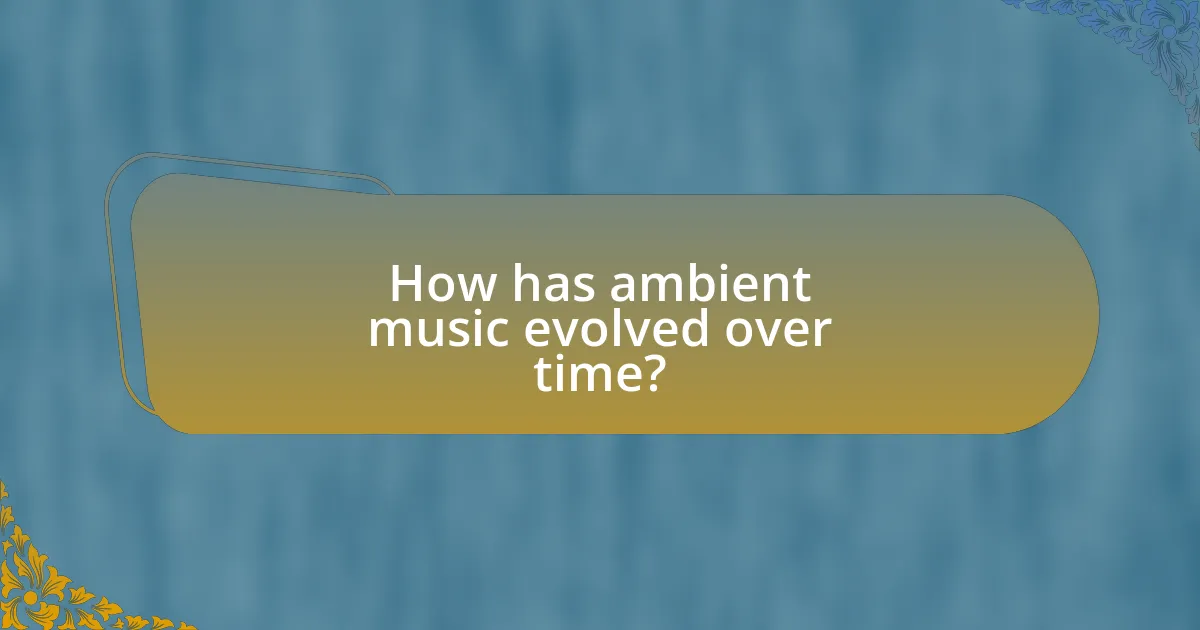
How has ambient music evolved over time?
Ambient music has evolved significantly since its inception in the late 1950s and early 1960s, transitioning from experimental soundscapes to a diverse genre encompassing various styles. Initially pioneered by artists like John Cage and later popularized by Brian Eno, ambient music focused on creating atmospheric sound environments rather than traditional musical structures. The genre expanded in the 1970s and 1980s with the incorporation of electronic instruments and synthesizers, leading to subgenres such as dark ambient and space music. By the 1990s and 2000s, ambient music further diversified, integrating elements from genres like downtempo, chillout, and even pop, reflecting broader cultural influences and technological advancements. Today, ambient music continues to evolve, with artists utilizing digital platforms and sound design techniques to create immersive experiences, demonstrating its adaptability and relevance in contemporary music.
What are the historical roots of ambient music?
The historical roots of ambient music can be traced back to the early 20th century, particularly influenced by the works of composers like Erik Satie and John Cage. Erik Satie’s concept of “furniture music” in the 1910s emphasized background sound that could coexist with daily life, laying foundational ideas for ambient music. John Cage further expanded these concepts in the 1950s, particularly with his piece “4’33”,” which challenged traditional notions of music by highlighting environmental sounds. These early influences set the stage for the development of ambient music in the 1970s, notably through artists like Brian Eno, who coined the term “ambient music” and sought to create soundscapes that fostered a sense of atmosphere and space.
Who are the pioneers of the ambient music genre?
The pioneers of the ambient music genre include Brian Eno, who is often credited with popularizing the style through his 1975 album “Ambient 1: Music for Airports.” Other significant figures are Tangerine Dream, known for their electronic soundscapes, and Klaus Schulze, who contributed to the development of electronic music and ambient textures. These artists laid the groundwork for ambient music by emphasizing atmosphere and mood over traditional musical structure, influencing countless musicians and genres that followed.
How did technology influence the development of ambient music?
Technology significantly influenced the development of ambient music by enabling new sound manipulation techniques and accessibility to diverse audio sources. The advent of synthesizers in the 1960s, such as the Moog and ARP, allowed composers like Brian Eno to create layered textures and atmospheric soundscapes that defined the genre. Additionally, advancements in recording technology, including multi-track recording and digital audio workstations, facilitated complex arrangements and the blending of various sound elements. The use of field recordings and sampling technology further expanded the sonic palette, allowing artists to incorporate environmental sounds and create immersive auditory experiences. These technological innovations collectively shaped the evolution of ambient music, making it a distinct and influential genre.
What are the major subgenres of ambient music?
The major subgenres of ambient music include dark ambient, drone, space ambient, and ambient house. Dark ambient focuses on creating a haunting atmosphere, often using dissonant sounds and minimalistic structures, while drone emphasizes sustained tones and textures, creating a meditative experience. Space ambient is characterized by its ethereal soundscapes that evoke feelings of vastness and exploration, and ambient house blends ambient music with house beats, creating a rhythmic yet atmospheric sound. These subgenres illustrate the diversity within ambient music, each contributing unique elements to the overall genre.
How does drone music fit into the ambient genre?
Drone music is a subgenre of ambient music characterized by sustained tones and minimalistic structures. It fits into the ambient genre by emphasizing atmosphere and texture over traditional musical elements like melody and rhythm. The use of long, continuous sounds in drone music creates immersive soundscapes that align with ambient music’s goal of inducing relaxation and contemplation. Historical context supports this relationship, as artists like La Monte Young and Brian Eno have been pivotal in merging drone elements with ambient music, showcasing how drone techniques enhance the overall ambient experience.
What distinguishes dark ambient from other forms of ambient music?
Dark ambient is distinguished from other forms of ambient music primarily by its use of darker themes, unsettling soundscapes, and a focus on evoking feelings of dread or introspection. Unlike general ambient music, which often aims to create a serene or uplifting atmosphere, dark ambient incorporates elements such as dissonant tones, industrial sounds, and field recordings that contribute to a more ominous and immersive experience. This genre often draws on influences from horror, science fiction, and existential themes, creating a unique auditory environment that can provoke deep emotional responses.
What contemporary trends are shaping ambient music today?
Contemporary trends shaping ambient music today include the integration of technology, collaboration across genres, and a focus on immersive experiences. The rise of digital audio workstations and software synthesizers has enabled artists to create complex soundscapes with ease, allowing for innovative compositions that blend traditional ambient elements with electronic music. Collaborations with artists from various genres, such as pop, classical, and experimental music, have expanded the boundaries of ambient music, leading to diverse influences and styles. Additionally, the emphasis on immersive experiences, such as live performances in unique environments and the use of spatial audio technology, has transformed how audiences engage with ambient music, making it a more interactive and sensory experience. These trends reflect the evolving nature of ambient music and its adaptability to contemporary cultural and technological shifts.
How are modern artists redefining ambient soundscapes?
Modern artists are redefining ambient soundscapes by integrating diverse genres, technology, and personal narratives into their compositions. This evolution is evident in the blending of electronic elements with acoustic instruments, creating immersive experiences that challenge traditional boundaries of ambient music. For instance, artists like Brian Eno, often regarded as a pioneer, have influenced contemporary musicians to experiment with generative music techniques, where algorithms create evolving soundscapes. Additionally, the use of field recordings and environmental sounds has become prevalent, allowing artists to incorporate real-world textures into their work, thus enhancing the emotional depth and context of their pieces. This shift reflects a broader cultural movement towards personalization and interactivity in music, as seen in platforms that allow listeners to engage with soundscapes in unique ways.
What role do digital platforms play in the distribution of ambient music?
Digital platforms serve as crucial facilitators in the distribution of ambient music by providing accessible channels for artists to reach global audiences. These platforms, such as Spotify, Apple Music, and Bandcamp, enable independent and established musicians to upload their work, thereby bypassing traditional gatekeepers like record labels. This democratization of music distribution has led to a significant increase in the availability of ambient music, allowing listeners to discover a diverse range of artists and styles. According to a 2021 report by the International Federation of the Phonographic Industry, streaming accounted for 62% of global recorded music revenue, highlighting the pivotal role digital platforms play in shaping music consumption trends, including ambient genres.
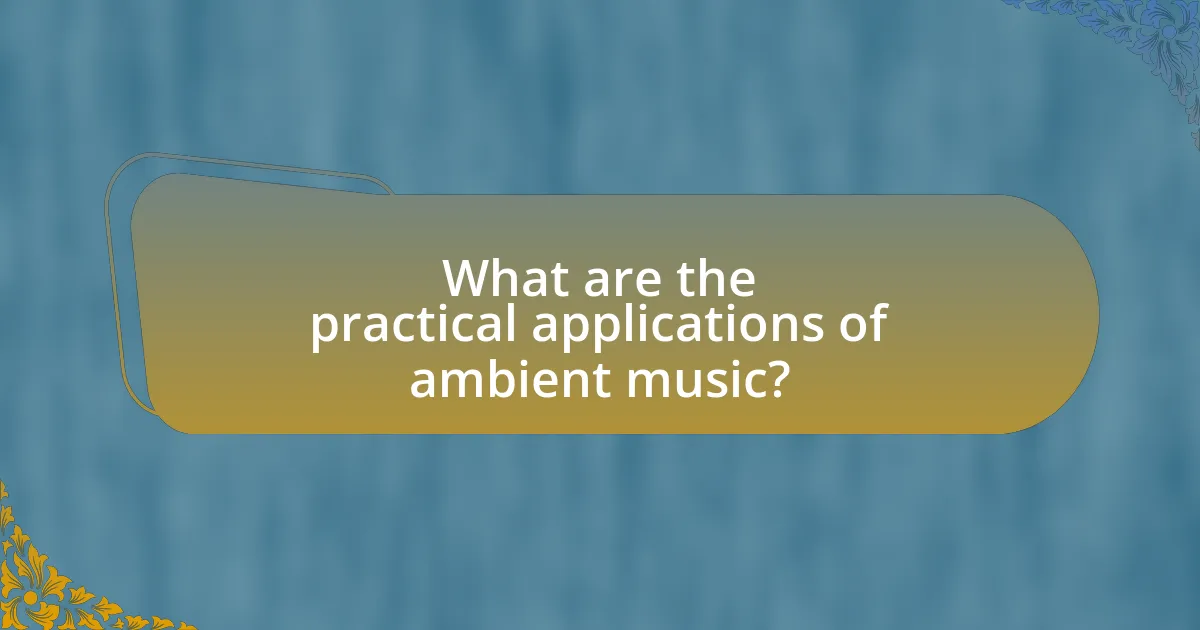
What are the practical applications of ambient music?
Ambient music has practical applications in various fields, including relaxation, therapy, and enhancing focus. In therapeutic settings, ambient music is used to reduce anxiety and promote a sense of calm, as evidenced by studies showing its effectiveness in stress relief and emotional regulation. For instance, research published in the Journal of Music Therapy indicates that ambient music can significantly lower cortisol levels, a hormone associated with stress. Additionally, in work environments, ambient music is employed to improve concentration and productivity, with studies revealing that background music can enhance cognitive performance by creating a more conducive atmosphere for tasks requiring focus. Furthermore, ambient music is utilized in public spaces, such as cafes and retail stores, to create an inviting ambiance that encourages customer engagement and prolongs their stay.
How is ambient music used in therapeutic settings?
Ambient music is used in therapeutic settings to promote relaxation, reduce anxiety, and enhance emotional well-being. Research indicates that ambient music can lower heart rates and cortisol levels, which are associated with stress reduction. For instance, a study published in the Journal of Music Therapy found that participants exposed to ambient music reported significant decreases in anxiety levels compared to those who were not. Additionally, ambient music is often utilized in practices such as guided imagery and meditation, where its soothing qualities help facilitate deeper states of relaxation and mindfulness.
What benefits does ambient music offer in mental health therapy?
Ambient music offers several benefits in mental health therapy, including stress reduction, improved mood, and enhanced relaxation. Research indicates that ambient music can lower cortisol levels, which are associated with stress, thereby promoting a sense of calm. A study published in the Journal of Music Therapy found that participants exposed to ambient music reported significant decreases in anxiety and depression symptoms. Additionally, ambient music can facilitate mindfulness practices, allowing individuals to focus on the present moment, which is crucial for therapeutic outcomes. These benefits make ambient music a valuable tool in mental health therapy settings.
How does ambient music enhance mindfulness practices?
Ambient music enhances mindfulness practices by creating a serene auditory environment that promotes relaxation and focus. This genre of music often features slow tempos, gentle harmonies, and minimalistic structures, which can help reduce distractions and facilitate a deeper state of awareness. Research indicates that listening to ambient music can lower cortisol levels, thereby reducing stress and anxiety, which are barriers to effective mindfulness. A study published in the Journal of Music Therapy found that participants who engaged in mindfulness practices while listening to ambient music reported higher levels of relaxation and improved concentration compared to those who practiced in silence.
What role does ambient music play in multimedia projects?
Ambient music serves as a crucial element in multimedia projects by enhancing the emotional atmosphere and providing a sonic backdrop that supports visual content. This genre of music creates immersive experiences, allowing audiences to engage more deeply with the narrative or themes presented. Research indicates that ambient music can influence mood and perception, making it an effective tool for storytelling in film, video games, and interactive media. For instance, a study published in the Journal of Experimental Psychology found that background music significantly affects emotional responses, thereby validating the use of ambient soundscapes to evoke specific feelings in viewers or players.
How is ambient music utilized in film and video games?
Ambient music is utilized in film and video games to create immersive soundscapes that enhance emotional engagement and atmosphere. In films, ambient music often serves as a backdrop that supports the narrative, subtly influencing the viewer’s emotional response without overpowering dialogue or action. For instance, in films like “Blade Runner,” ambient soundscapes contribute to the futuristic setting and mood, reinforcing themes of isolation and existentialism.
In video games, ambient music is employed to establish a sense of place and time, guiding players through environments and enhancing gameplay experiences. Games such as “Journey” use ambient music to evoke feelings of exploration and wonder, with soundscapes that adapt to the player’s actions and surroundings. This dynamic interaction between music and gameplay fosters a deeper connection to the game world.
Research indicates that ambient music can significantly affect player immersion and emotional responses, as demonstrated in studies examining player engagement in various gaming contexts. Overall, ambient music plays a crucial role in shaping the auditory experience in both film and video games, enhancing storytelling and player engagement.
What impact does ambient music have on branding and advertising?
Ambient music significantly enhances branding and advertising by creating an emotional connection with consumers. This genre of music fosters a calming atmosphere, which can improve customer experience and increase brand recall. Research indicates that environments with ambient music can lead to longer customer dwell times and higher spending, as demonstrated in a study published in the Journal of Retailing, where ambient music positively influenced consumer behavior in retail settings. Additionally, brands that incorporate ambient music into their advertising can evoke specific emotions, aligning their message with the desired consumer response, thereby strengthening brand identity and loyalty.
What tips can enhance the experience of listening to ambient music?
To enhance the experience of listening to ambient music, create an immersive environment by minimizing distractions and optimizing acoustics. Research indicates that listening in a quiet space with soft lighting can significantly improve focus and emotional response to the music. Additionally, using high-quality headphones or speakers allows for a more detailed auditory experience, as ambient music often contains subtle layers and textures that are best appreciated with superior sound equipment. Engaging in activities such as meditation or deep breathing while listening can further deepen the experience, as studies show that ambient music can promote relaxation and mindfulness.
How can listeners create an ideal environment for enjoying ambient music?
Listeners can create an ideal environment for enjoying ambient music by ensuring a quiet, comfortable space with minimal distractions. This involves selecting a location that is free from noise pollution, such as traffic or conversations, which can disrupt the immersive experience that ambient music offers. Additionally, using soft lighting, such as dimmable lamps or candles, can enhance the atmosphere, allowing listeners to focus on the soundscapes without visual distractions. Research indicates that environments with controlled acoustics, such as soft furnishings that absorb sound, can further enhance the listening experience by reducing echoes and creating a more intimate sound field.
What are some recommended ambient music playlists for beginners?
Some recommended ambient music playlists for beginners include “Ambient Essentials” on Spotify, which features a curated selection of foundational ambient tracks, and “Chill Out Lounge” on Apple Music, known for its relaxing soundscapes. Additionally, “Deep Focus” on Spotify offers a mix of ambient and minimalist music designed to enhance concentration. These playlists are popular among listeners new to the genre, providing a gentle introduction to ambient music’s diverse styles and sounds.
